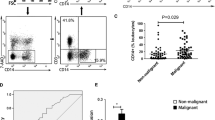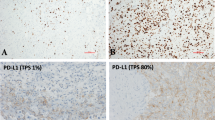Abstract
Background
Malignant pleural effusion (MPE) is a sign of advanced disease of poor prognosis. As natural killer (NK) cells are involved in the first line of tumour defence, we aimed to validate a new diagnostic and prognostic indicator for MPE based on NK subpopulations of pleural fluid (PF) and peripheral blood (PB).
Methods
NK subpopulations were determined in PF and PB in 71 patients with malignant, paramalignant or benign pleural effusion. The receiver operating characteristic (ROC) curves, Kaplan–Meier, multivariable Cox model and decision trees created with the CHAID (Chi-square automatic interaction detector) methodology were employed.
Results
We demonstrated that the PF/PB ratios of the CD56 bright CD16− and CD56 dim CD16− NK subpopulations were higher (p = 0.013 and p = 0.003, respectively) in MPEs and paramalignant pleural effusions (PPEs) than in benign ones, with an AUC of 0.757 and 0.741, respectively. The PF/PB ratio of CD16+ NK and CD57+ NK obtained a higher hazard ratio (HR) in the crude Cox’s regression analysis. In the adjusted Cox’s regression analysis, the PF/PB ratio of CD16+ NK gave the highest HR (HR 6.1 [1.76–21.1]) (p = 0.004). In the decision tree created for the MPE prognosis, we observed that the main predictor variable among the studied clinical, radiological, and analytical variables was lung mass, and that 92.9% of the patients who survived had a PF/PB ratio of the CD56 dim CD16+ NK subpopulation ≤ 0.43.
Conclusions
Our data suggest that both the PF/PB ratios of cytotoxic subpopulations CD57+ NK and CD16+ NK are useful as a prognostic factor of MPE. Other subpopulations (CD56 bright CD16− and CD56 dim CD16− NK) could help to diagnose MPE.




Similar content being viewed by others
Abbreviations
- MPE:
-
Malignant pleural effusion
- NK:
-
Natural killer
- PF:
-
Pleural fluid
- PB:
-
Peripheral blood
- ROC:
-
Receiver operating characteristic
- CHAID:
-
Chi-square automatic interaction detector
- CT:
-
Computed tomography
- PPE:
-
Paramalignant pleural effusion
- CEIC:
-
Committee of Ethics and Clinical Trials
- PBS:
-
Phosphate-buffered saline
- SD:
-
Standard deviation
- AUC:
-
ROC area under the curve
- CI:
-
Confidence intervals
- BPE:
-
Benign pleural effusion
- HR:
-
Hazard ratio
References
Villena Garrido V, Cases Viedma E, Fernández Villar A, de Pablo Gafas A, Pérez Rodríguez E, Porcel Pérez JM et al (2014) Normativa sobre el diagnóstico y tratamiento del derrame pleural. Actualización. Arch Bronconeumol 50:235–249
Roberts ME, Neville E, Berrisford RG, Antunes G, Ali NJ (2010) Management of a malignant pleural effusion: British Thoracic Society pleural disease guideline 2010. Thorax 65(Suppl 2):ii32–ii40
Cornfield DB, Gheith SM (2009) Flow cytometric quantitation of natural killer cells and T lymphocytes expressing T-cell receptors alpha/beta and gamma/delta is not helpful in distinguishing benign from malignant body cavity effusions. Cytom B 76:213–217
Green LK, Griffin J (1996) Increased natural killer cells in fluids. A new, sensitive means of detecting carcinoma. Acta Cytol 40:1240–1245
Yu GH, Hida CA, Salhany KE, Baloch Z, Gupta PK (1999) Immunohistochemical detection of cytotoxic lymphocytes in malignant serous effusions. Diagn Cytopathol 21:18–21
Laurini JA, Garcia A, Elsner B, Bellotti M, Rescia C (2000) Relation between natural killer cells and neoplastic cells in serous fluids. Diagn Cytopathol 22:347–350
Sikora J, Dworacki G, Trybus M, Batura-Gabryel H, Zeromski J (1998) Correlation between DNA content, expression of Ki-67 antigen of tumor cells and immunophenotype of lymphocytes from malignant pleural effusions. Tumor Biol 19:196–204
Jezewska E, Sikora J, Slowik-Gabryelska A, Zeromski J (1993) Evaluation of immunophenotype of lymphoid cells isolated from malignant pleural effusions. Arch Immunol Ther Exp 41:51–56
Poli A, Michel T, Thérésine M, Andrès E, Hentges F, Zimmer J (2009) CD56 bright natural killer (NK) cells: an important NK cell subset. Immunology 126:458–465
Focosi D, Bestagno M, Burrone O, Petrini MCD (2010) 57+ T lymphocytes and functional immune deficiency. J Leukoc Biol 87:107–116
Lopez-Vergès S, Milush JM, Pandey S, York VA, Arakawa-Hoyt J, Pircher H et al (2010) CD57 defines a functionally distinct population of mature NK cells in the human CD56 dim CD16+ NK-cell subset. Blood 116:3865–3874
Nielsen CM, White MJ, Goodier MR, Riley EM (2013) Functional significance of CD57 expression on human NK cells and relevance to disease. Front Immunol 4:422
Villena Garrido V, Ferrer Sancho J, Hernández Blasco L, de Pablo Gafas A, Pérez Rodríguez E, Rodríguez Panadero F et al (2006) Diagnóstico y tratamiento del derrame pleural. Arch Bronconeumol 42:349–372
American Thoracic Society (2000) Management of malignant pleura effusions. Am J Respir Crit Care Med 162:1987–2001
Biggs D, De Ville B, Suen E (1991) A method of choosing multiway partitions for classification and decision trees. J Appl Stat 18:49–62
Scherpereel A, Grigoriu BD, Noppen M, Gey T, Chahine B, Baldacci S et al (2013) Defect in recruiting effector memory CD8+ T-cells in malignant pleural effusions compared to normal pleural fluid. BMC Cancer 13:324
Pace E, Di Sano C, Ferraro M, Tipa A, Olivieri D, Spatafora M et al (2011) Altered CD94/NKG2A and perforin expression reduce the cytotoxic activity in malignant pleural effusions. Eur J Cancer 47:296–304
Atanackovic D, Block A, de Weerth A, Faltz C, Hossfeld DK, Hegewisch-Becker S (2004) Characterization of effusion-infiltrating T cells: benign versus malignant effusions. Clin Cancer Res 10:2600–2608
Vacca P, Martini S, Garelli V, Passalacqua G, Moretta L, Mingari MC (2013) NK cells from malignant pleural effusions are not anergic but produce cytokines and display strong anti-tumor activity on short-term IL-2 activation. Eur J Immunol 43:550–561
Qi J, Li D, Feng J, Yang S, Su Y, Fang M et al (2013) Native soluble carcinoembryonic antigen is not involved in the impaired activity of CD56 natural killer cells in malignant pleural effusion. Respiration 86:216–223
Park BG, Park CJ, Yoon CH, Jang S, Chi HS, Ryu MH et al (2013) The extended leukocyte differential count using the Cytodiff flow cytometric system reveals that higher CD16+ cytotoxic NK+ T lymphocyte levels predict superior survival outcomes in patients with metastatic carcinoma. Cytom B 84:202–204
Sconocchia G, Zlobec I, Lugli A, Calabrese D, Iezzi G, Karamitopoulou E et al (2011) Tumor infiltration by FcγRIII (CD16)+ myeloid cells is associated with improved survival in patients with colorectal carcinoma. Int J Cancer 128:2663–2672
Dong HP, Elstrand MB, Holth A, Silins I, Berner A, Trope CG et al (2006) NK- and B-cell infiltration correlates with worse outcome in metastatic ovarian carcinoma. Am J Clin Pathol 125:451–458
Acknowledgements
The authors would like to thank the Pulmonology Foundation of the Valencian Community for the grant that this work was awarded with, and with which the monoclonal antibodies employed were obtained. They also thank everyone who collaborated either directly or indirectly in this research.
Funding
Dr. Susana Herrera Lara has received research scholarship support from the Pulmonology Foundation of the Valencian Community.
Author information
Authors and Affiliations
Contributions
SHL designed and conducted the research, collected, analysed and interpreted data, and wrote the manuscript. EF-F designed and conducted the research, interpreted the data, wrote the manuscript and critically revised the article. GJS critically revised the article. JMB analysed and interpreted the data. RAL analysed and interpreted the data. APM provided technical assistance. MMS-V analysed and interpreted the data, performed the statistical analysis and critically revised the article.
Corresponding author
Ethics declarations
Conflict of interest
We wish to confirm that there are no known conflicts of interest associated with this publication, and there has been no financial support for this work that could have influenced its outcome.
Ethical Approval
We further confirm that any aspect of the work covered herein that has involved human patients has been conducted with the ethical approval of all the relevant bodies, and that such approvals are acknowledged in the manuscript.
Rights and permissions
About this article
Cite this article
Herrera Lara, S., Fernández-Fabrellas, E., Juan Samper, G. et al. Cytotoxic Natural Killer Subpopulations as a Prognostic Factor of Malignant Pleural Effusion. Lung 197, 53–60 (2019). https://doi.org/10.1007/s00408-018-0186-7
Received:
Accepted:
Published:
Issue Date:
DOI: https://doi.org/10.1007/s00408-018-0186-7




